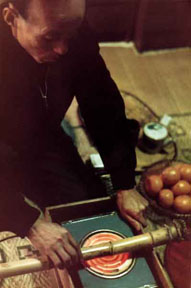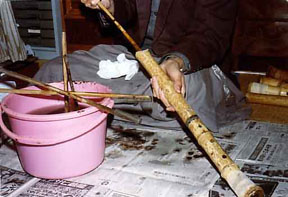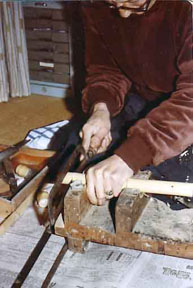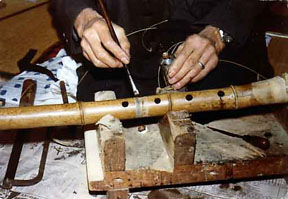|
|
Elmer Takeo Kudo KINKO SHAKUHACHI FLUTE: Shakuhachi Master Craftsman
|
|
|
Elmer Takeo Kudo KINKO SHAKUHACHI FLUTE: Shakuhachi Master Craftsman
|
In 1974, after studying shakuhachi for three years in his home state of Hawai’i, Elmer Takeo Kudo traveled to Japan intent upon researching and documenting the techniques and approaches used by traditional flute makers. It was his great fortune to meet Yoneda Chikamitsu, a master craftsman who had apprenticed with Yamaguchi Shiro, the father of Yamaguchi Goro who was later designated a Living National Treasure, the highest cultural honor awarded in Japan. During his stay in Japan, Mr. Kudo studied shakuhachi with Yamaguchi Goro who helped him immensely in his research documenting Mr. Yoneda’s work. This edition, completed in 1977, represents the fruit of that labor.
Kinko Shakuhachi: One Maker's Approach is, by far, the most thorough exploration of the traditional techniques used to make shakuhachi flutes currently available in English. It takes the reader, step-by-step, through the entire shakuhachi making process. Detailed descriptions are given for every aspect of the craft including location, selection, harvesting and curing of bamboo used for shakuhachi, straightening the culms, shaping the root end, measuring and drilling the finger holes, making the nakatsugi or mid-joint of a two-piece flute, wrapping the nakatsugi with rattan (to) binding, design and fabrication of the utaguchi or mouthpiece, making the precision bore inside the bamboo, using ji and urushi lacquer to build up and shape the inside of the flute and testing the finished instrument
It also includes a concise history of the shakuhachi, information on the approach and philosophy of shakuhachi making used by Yoneda-sensei, an extensive glossary of terms and bibliography of sources in both English and Japanese, a fingering chart used by the Chikumeisha branch of the Kinko-ryu and a comparison of two instruments whose sound has been analyzed by a sonagraph.
This revised edition, published nearly three decades after it was written, also includes 59 color and black-and-white photographs taken by the author as well as pages not previously included in the original publication.
64 pages. CM-30
 |
 |
 |
 |
CHAPTER TITLES |
||
Table of Contents I. INTRODUCTION Recent Publications II. BRIEF HISTORY Gagaku Shakuhachi III. THE INSTRUMENT Bamboo IV. A MAKER: YONEDA CHIKAMITSU Vita |
V. CONSTRUCTION PROCESS Taketori: Obtaining Bamboo Taketame: Straightening the Bamboo Mewari: Measuring the Finger Holes Nakatsugi: Making the Mid-joint Teana: Making the Finger Holes Utaguchi: Making the Mouth End Kanjiri: Drilling Through the Bell End Testing the Instrument |
VI. CONCLUSION APPENDIX A: Glossary of Instrument-Making Terms Used by Yoneda Chikamitsu APPENDIX B: Basic Fingering Chart of the Chikumeisha Branch of the Kinko-ryu APPENDIX C: A Sound Comparison of Two Shakuhachi BIBLIOGRAPHY: English and Japanese Language Sources ABOUT THE AUTHOR |
Elmer Takeo Kudo is Professor of Music at the University of Hawai’i at Manoa in Theory and Composition. His post-baccalaureate studies in music earned him degrees in the areas of Theory, Ethnomusicology and Composition. Dr. Kudo served in the military as a member of the Air Force Academy Band and a full-time arranger with the U.S. Air Force Band in Washington, D.C. His preoccupation with the shakuhachi (since 1971) led to studies in Japan with the internationally-known Yamaguchi Gor (declared a “Living National Treasure” by the Japanese government) and instrument maker Yoneda Chikamitsu.
Since 1972, Dr. Kudo has embraced the idea of combining Western and non-Western influences in his compositions, producing works that have been performed by many college and professional orchestras and chamber ensembles. In 1992, he was the featured composer at the “Festival of Japanese and Japanese-American Composers” at the University of Minnesota and was awarded the “1999 Individual Artist Performing Arts Fellowship” by the Hawai’i State Foundation on Culture and Arts. His Let Freedom Ring! (for solo taiko and orchestra) was premiered in January 1999 by the Honolulu Symphony Orchestra (Samuel Wong, conductor), performed by the Hong Kong Philharmonic in 2001 and again by the Honolulu Symphony in 2002.
Other recent performances include: “Wooden” (for clarinet and piano) by clarinetists Henry Miyamura, Margaret Donaghue and Paul Green; “One Sunday” by pianist Thomas Osuga; “Boxsteps for Two” by saxophone/piano duo Todd Yukumoto and HyeKyung Lee; East Drift by the Tokyo Shakuhachi Gassodan; “Into the Tranquil Circle” (for solo shakuhachi, strings, harp and percussion) by the University of Hawai’i and Philadelphia Orchestras; “Interlude” by the UH Orchestra; and Purple Verses by sopranos Barbara Kudo, Vicky Gorman and Judith Kellock.
Dr. Kudo is a member of the Society of Composers (SCI), BMI and UGH (Ukulele Guild of Hawai’i).
| Price of Book | Ordering Information |
|
Learn more about making shakuhachi
flutes |